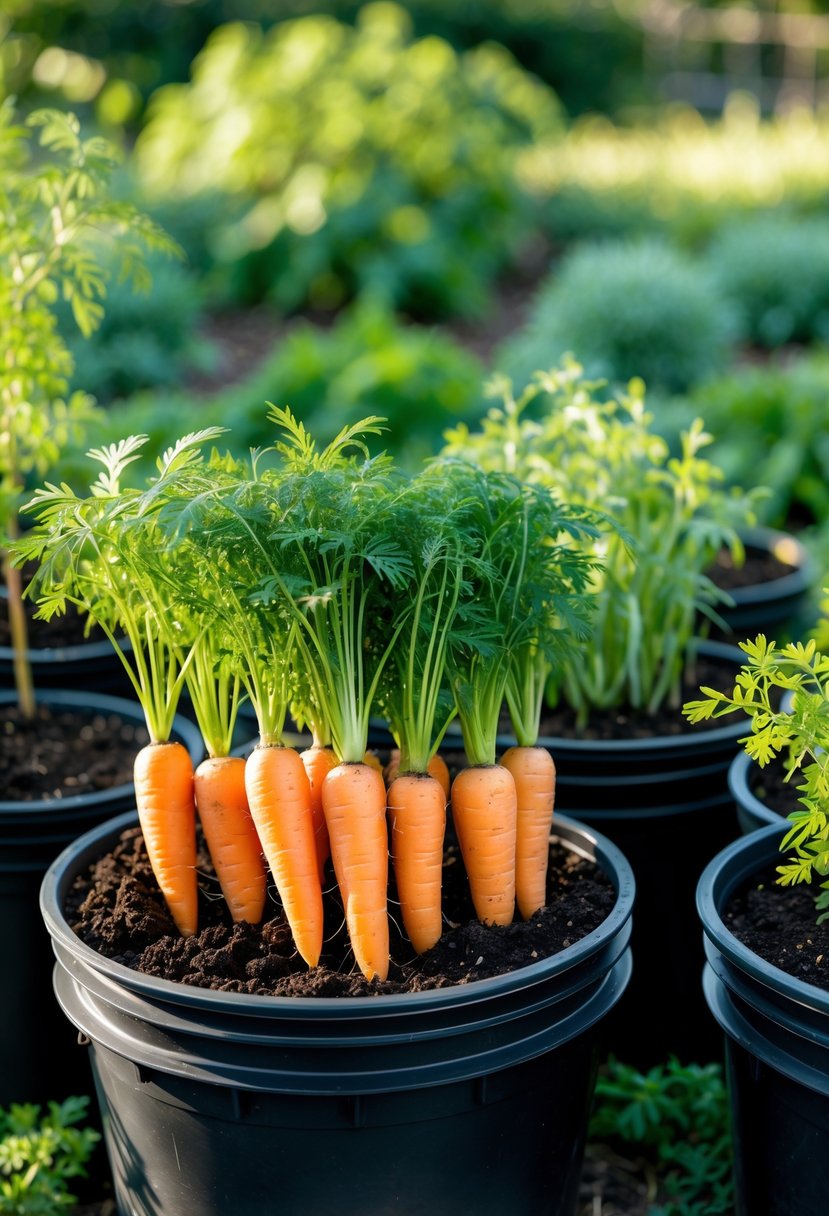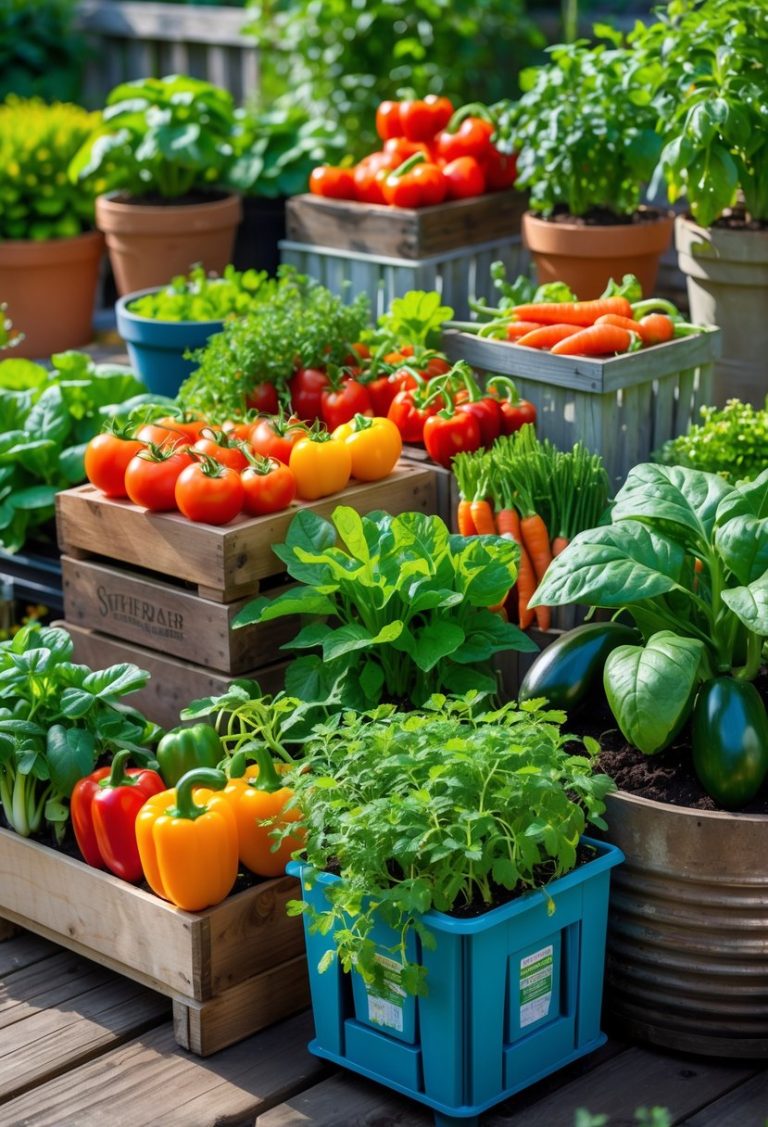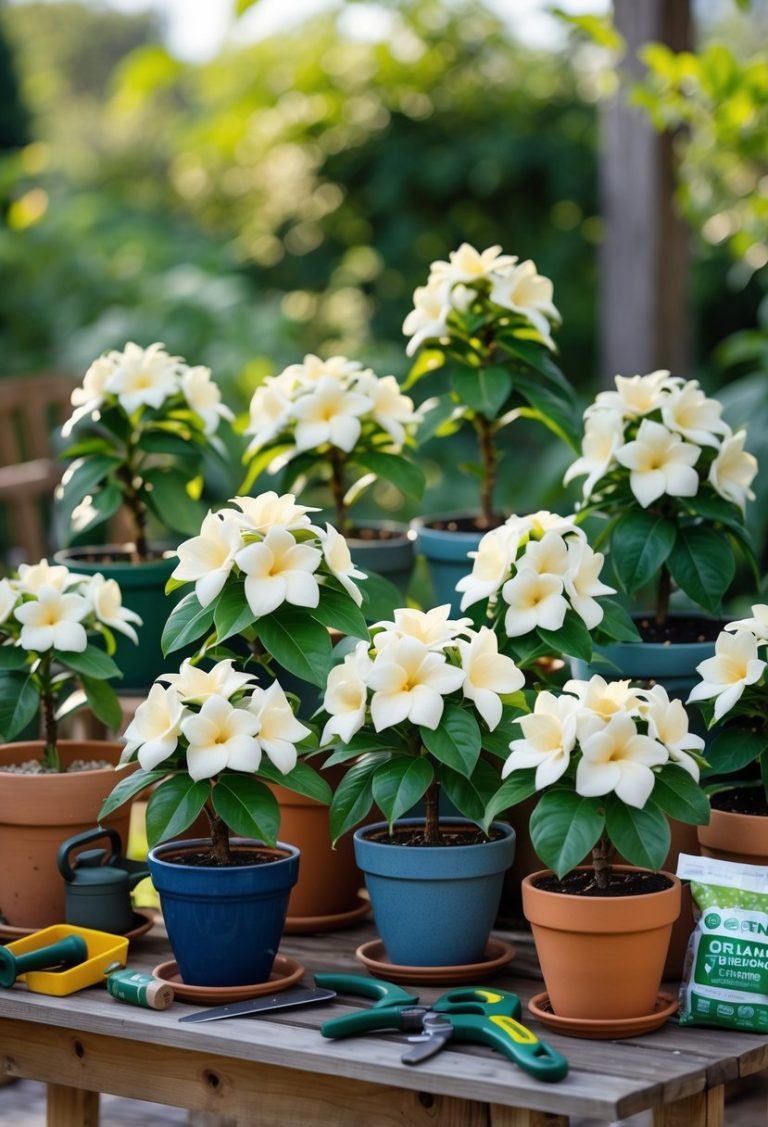8 Foods You Can Grow In Buckets All Year For Easy Urban Gardening
Growing food in buckets is a great way to have fresh produce even if you have limited space. Whether you live in a small apartment, have a balcony, or a small backyard, bucket gardening makes it easy to grow your own vegetables and herbs. It also lets you control the soil and water conditions better than traditional garden beds.

You can grow a variety of foods in buckets throughout the year, giving you access to fresh ingredients no matter the season. This method works well because buckets hold the right amount of soil and can be moved to catch the best sunlight. With some care, you can enjoy homegrown food all year long.
1) Cherry Tomatoes

You can grow cherry tomatoes successfully in buckets anytime during the year. Choose a bucket that holds at least 5 gallons and has good drainage.
Place your bucket where the plants get 6 to 8 hours of sunlight daily.
Pick compact or determinate cherry tomato varieties, as they fit well in containers.
Water regularly but avoid overwatering to keep the soil moist, not soggy.
2) Strawberries

You can grow strawberries easily in buckets. They need good soil and plenty of sunlight, about 6-8 hours a day.
Using a trellis or hanging basket helps save space and keeps the berries off the soil.
Water your strawberries regularly to keep the soil moist but not soggy. With the right care, you can enjoy fresh berries year-round.
3) Bell Peppers

You can grow bell peppers easily in buckets. Choose a 5-gallon bucket with good drainage holes.
Place your bucket in a spot that gets 6 to 8 hours of sunlight daily. Use well-draining soil and keep it moist but not soggy.
Support your plants with stakes or cages as they grow. Bell peppers need warm temperatures to thrive.
4) Lettuce

You can grow lettuce easily in buckets. It needs good sunlight, about 6 hours a day, and well-drained soil.
Loose-leaf lettuce is a good choice because you can pick leaves and let the plant keep growing.
Keep the soil moist but not wet. Lettuce grows fast, so you can harvest multiple times in a season. It’s a great option for small spaces.
5) Carrots

You can grow carrots in buckets by choosing shorter varieties like Nantes or Parisian. These types fit well in containers and develop better in limited space.
Use a deep bucket with loose, well-draining soil to help roots grow straight and avoid crowding. Keep the soil moist but not wet.
Carrots need at least 6 hours of sunlight daily. With proper care, you can harvest fresh, crunchy carrots year-round.
6) Radishes

Radishes grow quickly and do well in buckets. You only need a shallow bucket, about 6 to 8 inches deep, for them to thrive.
They prefer cooler weather and can be ready to harvest in as little as 3 to 4 weeks. This makes them a great option for growing multiple times a year.
You don’t need much work to keep them healthy. Just make sure they get enough water and sunlight.
7) Green Beans (bush variety)

You can grow bush green beans easily in buckets. They don’t take much space and are good for small areas like balconies or patios.
Plant 2 to 3 seeds per bucket, spacing them about an inch apart. Bush beans grow quickly and usually mature in 50 to 60 days.
If you prefer, you can use a small trellis for support, but bush beans often don’t need one. Just make sure your bucket has good soil and drainage.
8) Spinach

You can grow spinach in buckets all year if you provide enough light and cool temperatures. Spinach grows well in 5-gallon buckets filled with good soil.
You should water it regularly to keep the soil moist but not soggy. Harvest leaves often to encourage new growth. Spinach is a great choice for fresh, nutritious greens from your own container garden.
Best Practices For Year-Round Bucket Gardening

To grow food in buckets throughout the year, you must focus on choosing the proper containers, ensuring good soil and drainage, and adapting your setup depending on where you place your garden. Paying attention to these details helps your plants stay healthy and productive.
Selecting the Right Containers
Use buckets that are at least 5 gallons in size. This size allows enough space for roots to grow and hold enough soil and water. You can use plastic or food-grade buckets because they are lightweight and easy to move.
Make sure the buckets are sturdy and clean. Avoid containers that held toxic substances. You should also consider buckets with handles or wheels if you need to move them around your space.
Drill holes in the bottom of the bucket to allow water to drain. Without proper drainage, roots can rot, and plants will suffer. The number of holes depends on the bucket size, but usually 5-10 small holes work well.
Soil and Drainage Recommendations
Use a soil mix designed for container gardening, which typically includes potting soil, compost, and perlite or vermiculite. This mix holds moisture but drains well, preventing waterlogging.
Avoid using garden soil, as it can compact and stop water from flowing properly. Keep the soil light and loose so roots get oxygen.
Check the drainage holes regularly to make sure they are not blocked. You can also add a layer of small stones or broken pottery at the bottom of the bucket to improve drainage.
Water your plants consistently, but avoid overwatering. Feel the soil with your fingers; water when the top inch feels dry.
Adjusting for Indoor and Outdoor Setups
If you grow indoors, place your buckets in a sunny window or use grow lights that provide 12-16 hours of light daily. Indoor plants may need more frequent watering because air indoors can be dry.
For outdoor gardening, set your buckets where plants get enough sun—usually 6 or more hours—depending on the crop. Protect your buckets from strong winds and heavy rain.
In colder months, you can bring buckets indoors or use covers like plastic cloches to keep soil warmer. Make sure outdoor buckets do not stay wet from rain to avoid root damage.
These adjustments help create the right environment for your plants all year.
Maximizing Harvests and Plant Health

To get the best results from growing food in buckets, you need to manage light, temperature, watering, and fertilizing carefully. These factors affect how well your plants grow and produce. Paying attention to them keeps your plants healthy all year.
Managing Light and Temperature
Your plants need plenty of light to grow well. Most vegetables require at least 6 hours of direct sunlight daily. Place your buckets where they get the most sunlight, such as a south-facing balcony or porch.
If natural light is limited, consider using grow lights. LED grow lights work well and can fill in gaps during darker months.
Temperature also impacts growth. Most vegetables prefer temperatures between 60°F and 75°F. Avoid placing buckets in areas that get too hot or cold. In winter, you might need to bring buckets indoors or use a heat mat.
Fertilizing and Watering Techniques
Using the right fertilizer keeps your plants strong. Choose a balanced, water-soluble fertilizer with equal parts nitrogen, phosphorus, and potassium (such as 10-10-10). Feed your plants every 2-3 weeks during the growing season.
Water your buckets regularly to keep soil moist but not soggy. Check moisture daily by sticking your finger about an inch into the soil—if it feels dry, it’s time to water.
Use buckets with drainage holes to prevent water buildup, which can cause root rot. Mulching the top of the soil helps keep moisture in and reduces watering frequency.






